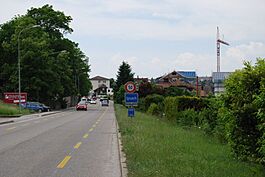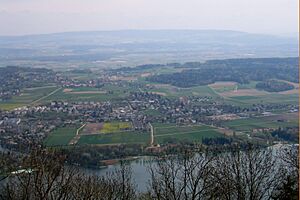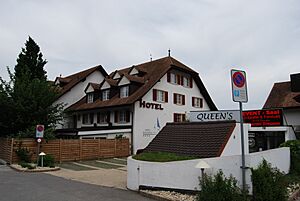Ipsach facts for kids
Quick facts for kids
Ipsach
|
||
|---|---|---|

Ipsach village
|
||
|
||
| Country | Switzerland | |
| Canton | Bern | |
| District | Biel/Bienne | |
| Area | ||
| • Total | 1.9 km2 (0.7 sq mi) | |
| Elevation | 442 m (1,450 ft) | |
| Population
(Dec 2020 )
|
||
| • Total | 3,913 | |
| • Density | 2,060/km2 (5,330/sq mi) | |
| Postal code |
2563
|
|
| Surrounded by | Bellmund, Biel/Bienne, Nidau, Port, Sutz-Lattrigen, Tüscherz-Alfermée | |
Ipsach is a small town, also called a municipality, located in Switzerland. It's part of the Biel/Bienne area in the canton of Bern. Ipsach sits right by Lake Biel, making it a beautiful place to live.
Contents
History of Ipsach
Ipsach was first mentioned in old records around the years 1265-1266. Its name back then was Ipzacho.
Early Settlements in Ipsach
The land around Ipsach has been home to people for a very long time. People lived here during the neolithic (New Stone Age), Bronze Age, and Hallstatt eras. These were periods of history before written records. The old swampy areas, called peat moss, near the village have many ancient tools and items.
During the Roman era, a small town existed near what is now Oberdorf-Buchseefeld. Parts of a Roman road leading to Petinesca have been found in the Ipsachmoos area.
Ipsach in the Middle Ages
By the Late Middle Ages, there were two main settlements here: the Ipsach farm and a village called Wiler. These places were part of the Herrschaft of Nidau. A Herrschaft was like a local territory ruled by a lord. St. Alban's Monastery in Basel also owned some land and rights in Ipsach.
In 1335, the ruler of Nidau sold Ipsach and Wiler to the Counts of Neuchâtel-Nidau. Later, in 1382, the town of Fribourg took over ownership. Then, in 1398, Bern gained control. Under Bern's rule, Ipsach and Wiler became part of the bailiwick of Nidau. A bailiwick was an area managed by a local official. Over time, Wiler became smaller. By 1551, it was just a farm and soon after, it was completely abandoned.
Modern Ipsach: Growth and Change
People in Ipsach used to make a living by farming and fishing in Lake Biel. A big project called the Jura water correction happened between 1868 and 1891. This project lowered the water level in the lake. It created new land from the marshy areas, which could then be used for farming.
Ipsach's location by the lake made it easy for people to travel to nearby towns like Biel and Neuchâtel. In 1916, a railway line, the Biel-Täuffelen-Ins railroad, made it even easier to connect with other towns.
Starting in the 1950s, Ipsach began to grow quickly. It became a popular place for people who worked in Biel to live. In the 1980s, new buildings like a community center, a church, and sports facilities were built for the growing population. In 1989, Ipsach became the center of its own parish (a church district). Today, many people living in Ipsach travel to jobs and schools in Nidau and Biel.
Geography of Ipsach
Ipsach covers an area of about 1.9 square kilometers (0.73 square miles). A large part of this land, about 45%, is used for farming. About 3.7% of the area is covered by forests. The biggest part, about 50.3%, is settled land, meaning it has buildings or roads. Only a tiny bit, 0.5%, is unproductive land.
Most of the settled land is made up of houses and other buildings (30.9%). Roads and other transport areas make up 8.9%. Parks and sports fields cover 6.8% of the land. All the forested land in Ipsach is covered with thick forests. For farming, most of the land is used for growing crops (37.7%), and a smaller part is used for pastures (6.3%).
Ipsach is located on the right bank of Lake Biel. This means it's on the side of the lake that faces east if you're looking north.
In 2010, Ipsach became part of a new administrative area called Verwaltungskreis Biel/Bienne. Before that, it was in the Amtsbezirk Nidau district.
Coat of Arms
The coat of arms is like a special symbol or flag for the town. Ipsach's coat of arms is described as: Per fess Or a Sickle Azure fesswise and of the last a Perch naiant Argent. This means it has two main parts. The top part is gold (Or) and shows a blue (Azure) sickle (a curved tool for cutting crops) lying flat. The bottom part is blue and shows a silver (Argent) fish called a perch swimming.
People of Ipsach (Demographics)
Ipsach has a population of about 3,898 people (as of December 2011). About 10.3% of the people living here are foreign nationals (not Swiss citizens). Over the past ten years, the population has changed only a little.
Most people in Ipsach speak German as their first language (about 86.9%). French is the second most common language (8.8%), followed by Italian (1.0%).
In 2008, about 49.8% of the population was male and 50.2% was female. Most people living in Ipsach were born in Switzerland. About 16.2% were born in Ipsach itself.
In 2011, children and teenagers (ages 0-19) made up about 21.2% of the population. Adults (20-64 years old) made up 59.2%, and seniors (over 64 years old) made up 19.5%.
Many people in Ipsach are married (about 1,683 people in 2000). There are also single people, widows, and divorced individuals.
In 2010, there were 487 households (homes) with only one person. There were 97 households with five or more people. Most apartments in Ipsach are lived in all the time.
The chart below shows how Ipsach's population has grown over the years:

Economy of Ipsach
In 2011, Ipsach had a low unemployment rate of 1.66%. This means most people who wanted jobs had them. In 2008, there were 612 people working in Ipsach.
Economic Sectors
Jobs are often grouped into three main types:
- Primary sector: This includes jobs that get raw materials from nature. In Ipsach, 21 people worked in this sector, mostly in farming.
- Secondary sector: This involves making things. About 190 people worked in this sector, mainly in manufacturing (making products) and construction (building things).
- Tertiary sector: This includes jobs that provide services. About 401 people worked in this sector. These jobs include sales, transportation, hotels, restaurants, finance, education, and healthcare.
Many people who live in Ipsach travel to other towns for work. In 2000, about 1,583 people left Ipsach for work, while 352 people came into Ipsach to work. This means Ipsach sends out more workers than it brings in. About 43.5% of the people who work in Ipsach also live there.
Transportation for Work
When it comes to getting to work, about 19.1% of working people used public transportation. A larger number, 54.6%, used a private car.
Taxes and Income
In 2011, the average tax rate for a married person with two children in Ipsach was 12%. For an unmarried person, it was 17.7%. These rates are lower than the average for the whole canton of Bern. In 2009, many people in Ipsach earned over 75,000 Swiss francs (CHF) per year. The average income for this group was 124,310 CHF.
A small number of people, about 3.2% of the population in 2011, received financial help from the government.
Religion in Ipsach
Based on a survey in 2000, most people in Ipsach belonged to a Christian church. About 62.2% were part of the Swiss Reformed Church. Another 20.0% were Roman Catholic.
A smaller number of people belonged to other Christian groups, like Orthodox churches or the Christian Catholic Church. Some people also followed other religions, such as Islam (2.3%), Buddhist (10 people), or Hindu (1 person).
About 10.66% of the population said they did not belong to any church. These people might be agnostic (not sure if God exists) or atheist (do not believe in God).
Education in Ipsach
Education is very important in Ipsach. About 60.9% of the people have finished non-mandatory upper secondary education. This is like high school. Also, 22.5% have gone on to higher education, which means they attended a university or a special college called a Fachhochschule.
School System in Bern
The school system in the Canton of Bern works like this:
- Kindergarten: One year of non-obligatory (optional) kindergarten.
- Primary School: Six years of primary school.
- Lower Secondary School: Three years of required lower secondary school. Students are grouped based on their abilities.
- After lower secondary school, students can choose to continue their education or start an apprenticeship (learning a trade on the job).
Students in Ipsach
During the 2011-2012 school year, 310 students attended classes in Ipsach.
- There were 4 kindergarten classes with 86 students. Some of these students (11.6%) were not Swiss citizens, and some (19.8%) spoke a different language at home than the classroom language.
- There were 12 primary classes with 224 students. Similar to kindergarten, some primary students (11.2%) were not Swiss citizens, and some (17.9%) had a different mother language.
In 2000, most students (217 out of 219) who went to school in Ipsach also lived there. However, 213 residents of Ipsach went to schools outside the municipality.
See also
 In Spanish: Ipsach para niños
In Spanish: Ipsach para niños






